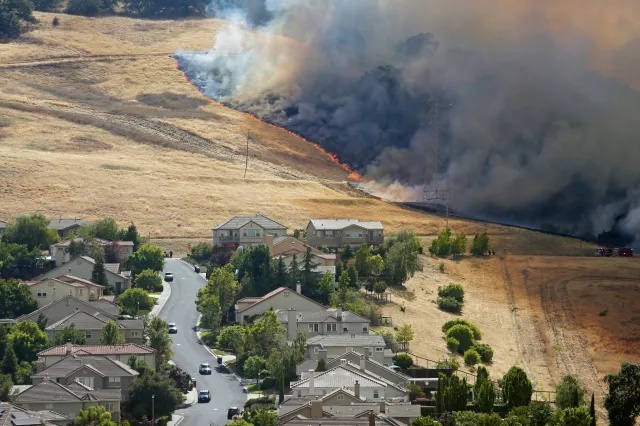A ubiquitous, resilient and seemingly harmless plant is fueling an increase in large, fast-moving and destructive wildfires in the United States.
Grass is as plentiful as sunshine, and under the right weather conditions is like gasoline for wildfires: All it takes is a spark for it to explode.
Planet-warming emissions are wreaking havoc on temperature and precipitation, resulting in larger and more frequent fires. Those fires are fueling the vicious cycle of ecological destruction that are helping to make grass king.
“Name an environment and there’s a grass that can survive there,” said Adam Mahood, research ecologist with the US Department of Agriculture’s research service. “Any 10-foot area that’s not paved is going to have some kind of grass on it.”
Grass fires are typically less intense and shorter-lived than forest fires, but can spread exponentially faster, outrun firefighting resources and burn into the growing number of homes being built closer to fire-prone wildlands, fire experts told CNN.
Over the last three decades, the number of US homes destroyed by wildfire has more than doubled as fires burn bigger and badder, a recent study found. Most of those homes were burned not by forest fires, but by fires racing through grass and shrubs.
The West is most at risk, the study found, where more than two-thirds of the homes burned over the last 30 years were located. Of those, nearly 80% were burned in grass and shrub fires.
One part of the equation is people are building closer to fire-prone wildlands, in the so-called wildland-urban interface. The amount of land burning in this sensitive area has grown exponentially since the 1990s. So has the number of houses. Around 44 million houses were in the interface as of 2020, an increase of 46% over the last 30 years, the same study found.
Building in areas more likely to burn comes with obvious risks, but because humans are also responsible for starting most fires, it also increases the chance a fire will ignite in the first place.
More than 80,000 homes are in the wildland-urban interface, in the sparsely populated parts of Kansas and Colorado that Bill King manages. The US Forest Service officer said living on the edge of nature requires an active hand to prevent destruction.
Property owners “need to do their part too, because these fires – they get so big and intense and sometimes wind-driven that they could spot miles ahead even if we have a huge fuel break,” King said.
‘A perfect storm’ for fire
Climate change-fueled fire is attacking the western half of the US on all fronts.
“Globally, the places that burn the most are places that have intermediate precipitation,” said John Abatzoglou, a climate professor at the University of California, Merced. “It’s a little bit like Goldilocks. Not too wet, not too dry, just right, with plenty of ignition.”
In America’s grassy heartland, the typically dry and often windy Plains, a series of compounding extremes across seasons are creating ideal fire fuel conditions in perennial grasses. Grass is more plentiful here than in other regions in the US, offering more continuous fuel for fires to feed off.
The region is seeing more megafires like Texas’s largest fire, the Smokehouse Creek Fire, and more destructive ones like Colorado’s Marshall Fire, which burned through more than 1,000 homes in 2021.
Rainy springs fuel more grass growth. Then it goes dormant, or plays dead, in the winter. Warmer winters with less snow cover, especially in the Northern Plains, expose the grass to warmer, drier spells in the late winter and early spring, according to King and Todd Lindley, a fire weather expert for the National Weather Service in Norman, Oklahoma.
Grass is uniquely flammable because of its sensitivity to weather, Lindley said. Unlike in forests, it doesn’t take long spells of warm, dry weather to turn grass to tinder. Moisture can be sapped from the plant in as little as an hour and even a day after rain. Throw in a spark, strong winds and invasive shrubs that burn hotter and longer and you have a recipe for grass fire disaster.
“These compound extremes, these sequences of extremes that follow one another, if you get the right sequence, it can be game on for this sort of wildfire,” Abatzoglou said. “Basically, you’re creating a perfect storm for the fire to spread there.”





